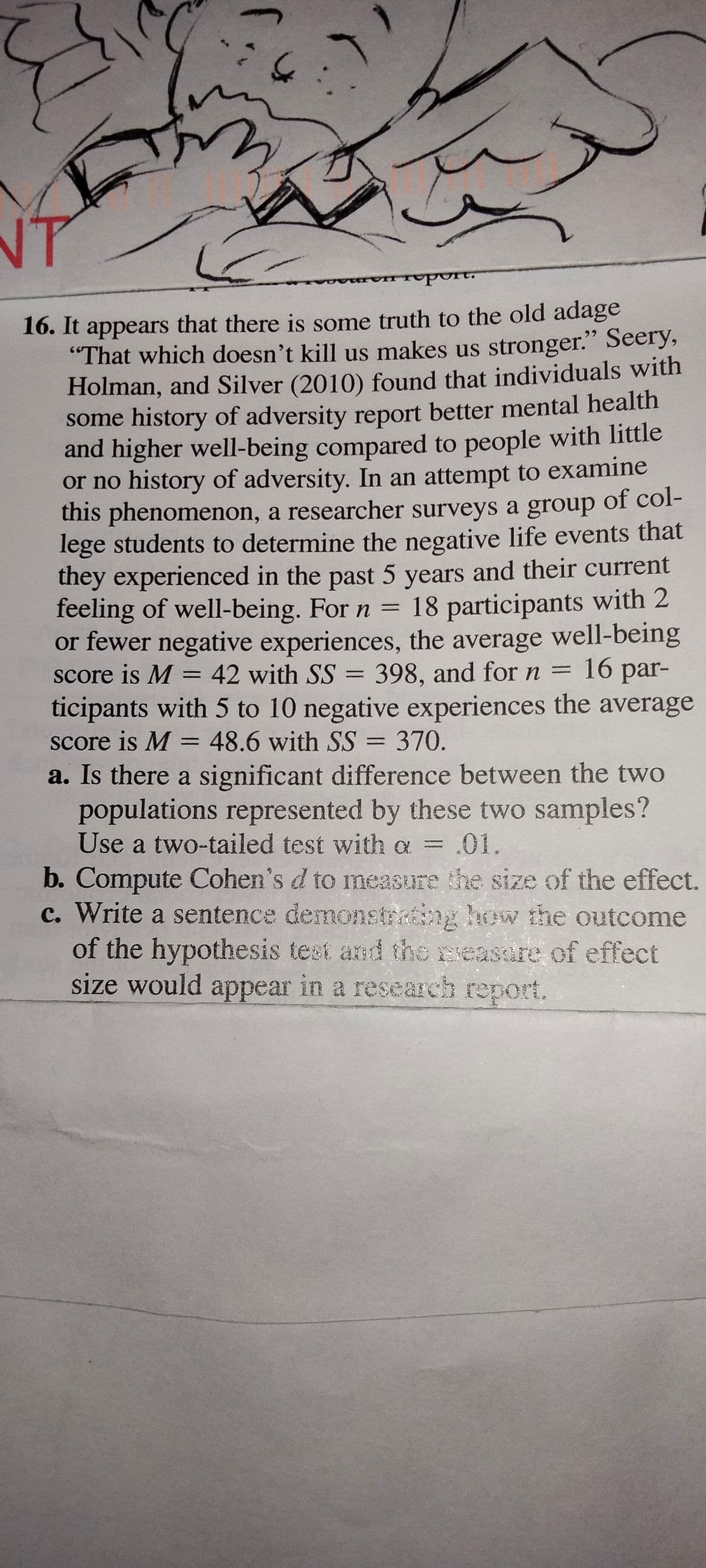16. It appears that there is some truth to the old adage "That which doesn't kill us makes us stronger." Seery, Holman, and Silver (2010) found that individuals with some history of adversity report better mental health and higher well-being compared to people with little or no history of adversity. In an attempt to examine this phenomenon, a researcher surveys a group of col- lege students to determine the negative life events that they experienced in the past 5 years and their current feeling of well-being. For n = 18 participants with 2 or fewer negative experiences, the average well-being score is M = 42 with SS = 398, and for n = 16 par- ticipants with 5 to 10 negative experiences the average score is M = 48.6 with SS = 370. %3D %3D a. Is there a significant difference between the two populations represented by these two samples? Use a two-tailed test with a = .01. b. Compute Cohen's d to measure the size of the effect c. Write a sentence demonstrating how the outcome of the hypothesis test and the easure of effect size would appear in a research report.
16. It appears that there is some truth to the old adage "That which doesn't kill us makes us stronger." Seery, Holman, and Silver (2010) found that individuals with some history of adversity report better mental health and higher well-being compared to people with little or no history of adversity. In an attempt to examine this phenomenon, a researcher surveys a group of col- lege students to determine the negative life events that they experienced in the past 5 years and their current feeling of well-being. For n = 18 participants with 2 or fewer negative experiences, the average well-being score is M = 42 with SS = 398, and for n = 16 par- ticipants with 5 to 10 negative experiences the average score is M = 48.6 with SS = 370. %3D %3D a. Is there a significant difference between the two populations represented by these two samples? Use a two-tailed test with a = .01. b. Compute Cohen's d to measure the size of the effect c. Write a sentence demonstrating how the outcome of the hypothesis test and the easure of effect size would appear in a research report.
Algebra & Trigonometry with Analytic Geometry
13th Edition
ISBN:9781133382119
Author:Swokowski
Publisher:Swokowski
Chapter10: Sequences, Series, And Probability
Section10.2: Arithmetic Sequences
Problem 52E
Related questions
Question

Transcribed Image Text:NT
16. It appears that there is some truth to the old adage
"That which doesn't kill us makes us stronger." Seery,
Holman, and Silver (2010) found that individuals with
some history of adversity report better mental health
and higher well-being compared to people with little
or no history of adversity. In an attempt to examine
this phenomenon, a researcher surveys a group of col-
lege students to determine the negative life events that
they experienced in the past 5 years and their current
feeling of well-being. For n = 18 participants with 2
or fewer negative experiences, the average well-being
score is M = 42 with SS = 398, and for n =
ticipants with 5 to 10 negative experiences the average
score is M = 48.6 with SS = 370.
a. Is there a significant difference between the two
populations represented by these two samples?
Use a two-tailed test with a = .01.
16 par-
%3D
%3D
%3D
%3D
b. Compute Cohen's d to measure the size of the effect.
c. Write a sentence demonstrating how the outcome
of the hypothesis test and thS Exeasdre of effect
size would appear in a research report.
Expert Solution
This question has been solved!
Explore an expertly crafted, step-by-step solution for a thorough understanding of key concepts.
This is a popular solution!
Trending now
This is a popular solution!
Step by step
Solved in 2 steps

Recommended textbooks for you

Algebra & Trigonometry with Analytic Geometry
Algebra
ISBN:
9781133382119
Author:
Swokowski
Publisher:
Cengage

Algebra & Trigonometry with Analytic Geometry
Algebra
ISBN:
9781133382119
Author:
Swokowski
Publisher:
Cengage